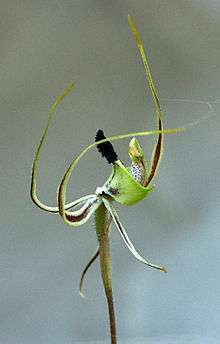Caladenia integra
| Smooth-lipped spider orchid | |
|---|---|
 | |
| Caladenia integra | |
| Scientific classification | |
| Kingdom: | Plantae |
| (unranked): | Angiosperms |
| (unranked): | Monocots |
| Order: | Asparagales |
| Family: | Orchidaceae |
| Genus: | Caladenia |
| Species: | C. integra |
| Binomial name | |
| Caladenia integra E. Coleman (1932) | |
| Synonyms[1] | |
| |
Caladenia integra, commonly known as the smooth-lipped spider orchid is a species of plant in the orchid family, Orchidaceae and is endemic to the south-west of Western Australia. It can be distinguished by its distinctive smooth-edged labellum and its upswept lateral sepals.
Description
Caladenia integra is a terrestrial, perennial, deciduous, herb with an underground tuber and a single hairy leaf, 150–250 mm (6–10 in) long and about 10 mm (0.4 in) wide. One or two flowers are produced on the end of a flowering stem 200–500 mm (8–20 in) tall. The flowers are 60–80 mm (2–3 in) across and 60–100 mm (2–4 in) long with green with maroon markings. The dorsal sepal is erect, 45–70 mm (2–3 in) long and 2–3 mm (0.08–0.1 in) wide. The lateral sepals are parallel and close together below the flower and are 40–60 mm (1.6–2.4 in) long, 3–5 mm (0.1–0.2 in) wide. They point downwards at their base but then curve upwards in front of the labellum. The petals are slighly shorter and narrower than the sepals and point downwards at an oblique angle. The labellum is loosely hinged to the column, 18–22 mm (0.7–0.9 in) long, 15–20 mm (0.6–0.8 in) wide, green to yellowish with a dark purple tip. Unlike other spider orchids, the edge of the labellum lacks teeth and has purplish calli crowded along its centre line.[2][3]
Taxonomy and naming
Caladenia integra was first described by Edith Coleman in 1932 in The Victorian Naturalist, from a specimen collected near Tunney.[1][4] In a review of the genus Caladenia in 2001, David Jones and Mark Clements proposed a name change to Arachnorchis integra[5] but the change has not been widely adopted. The specific epithet (integra) is a Latin word meaning "whole", "entire" or "complete".[6]
Distribution and habitat
The smooth-lipped orchid occurs in isolated populations between Clackline and Tenterden with a disjunct population near Kalbarri in the Avon Wheatbelt, Esperance Plains, Geraldton Sandplains, Jarrah Forest and Mallee biogeographic regions. It mainly grows under sheoak trees on granite outcrops.[2][3][7]
Conservation
Caladenia integra is classified as "Priority Four" by the Government of Western Australia Department of Parks and Wildlife,[7] meaning that is rare or near threatened.[8]
References
- 1 2 "Caladenia integra". APNI. Retrieved 30 July 2016.
- 1 2 Jones, David L. (2006). A complete guide to native orchids of Australia including the island territories. Frenchs Forest, N.S.W.: New Holland. p. 96. ISBN 1877069124.
- 1 2 Hoffman, Noel; Brown, Andrew (2011). Orchids of South-West Australia. (3rd ed.). Gooseberry Hill: Noel Hoffman. p. 148. ISBN 9780646562322.
- ↑ Coleman, Edith (1932). "Description of a new Caladenia (Orchid)". The Victorian Naturalist. 49: 246. Retrieved 30 July 2016.
- ↑ Hopper, Stephen D.; Brown, Andrew P. (29 April 2004). "Robert Brown's Caladenia revisited, including a revision of its sister genera Cyanicula, Ericksonella and Pheladenia (Caladeniinae: Orchidaceae)". Australian Systematic Botany. 17 (2): 171–240. doi:10.1071/sb03002.
- ↑ Brown, Roland Wilbur (1956). The Composition of Scientific Words. Washington, D.C.: Smithsonian Institution Press. p. 79.
- 1 2 "Caladenia integra". FloraBase. Western Australian Government Department of Parks and Wildlife.
- ↑ "Conservation codes for Western Australian Flora and Fauna" (PDF). Government of Western Australia Department of Parks and Wildlife. Retrieved 30 July 2016.
External links
 Media related to Caladenia integra at Wikimedia Commons
Media related to Caladenia integra at Wikimedia Commons Data related to Caladenia integra at Wikispecies
Data related to Caladenia integra at Wikispecies
